mirror PONTIAC GRAND PRIX 2007 Owners Manual
[x] Cancel search | Manufacturer: PONTIAC, Model Year: 2007, Model line: GRAND PRIX, Model: PONTIAC GRAND PRIX 2007Pages: 526, PDF Size: 2.92 MB
Page 1 of 526
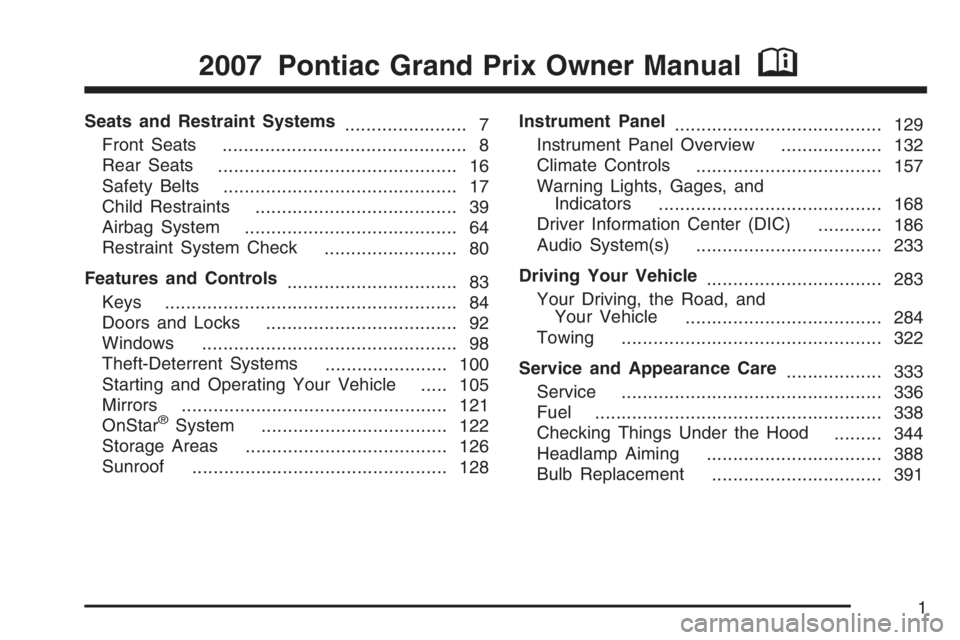
Seats and Restraint Systems
....................... 7
Front Seats
.............................................. 8
Rear Seats
............................................. 16
Safety Belts
............................................ 17
Child Restraints
...................................... 39
Airbag System
........................................ 64
Restraint System Check
......................... 80
Features and Controls
................................ 83
Keys
....................................................... 84
Doors and Locks
.................................... 92
Windows
................................................ 98
Theft-Deterrent Systems
....................... 100
Starting and Operating Your Vehicle
..... 105
Mirrors
.................................................. 121
OnStar
®System
................................... 122
Storage Areas
...................................... 126
Sunroof
................................................ 128Instrument Panel
....................................... 129
Instrument Panel Overview
................... 132
Climate Controls
................................... 157
Warning Lights, Gages, and
Indicators
.......................................... 168
Driver Information Center (DIC)
............ 186
Audio System(s)
................................... 233
Driving Your Vehicle
................................. 283
Your Driving, the Road, and
Your Vehicle
..................................... 284
Towing
................................................. 322
Service and Appearance Care
.................. 333
Service
................................................. 336
Fuel
...................................................... 338
Checking Things Under the Hood
......... 344
Headlamp Aiming
................................. 388
Bulb Replacement
................................ 391
2007 Pontiac Grand Prix Owner ManualM
1
Page 83 of 526

Keys.............................................................. 84
Remote Keyless Entry (RKE) System.......... 86
Remote Keyless Entry (RKE) System
Operation................................................. 87
Doors and Locks.......................................... 92
Door Locks................................................. 92
Power Door Locks....................................... 94
Delayed Locking.......................................... 94
Programmable Automatic Door Locks.......... 95
Rear Door Security Locks........................... 95
Lockout Protection....................................... 96
Trunk.......................................................... 96
Windows....................................................... 98
Power Windows.......................................... 99
Sun Visors................................................ 100
Theft-Deterrent Systems............................. 100
Content Theft-Deterrent............................. 100
PASS-Key
®III ........................................... 102
PASS-Key®III Operation........................... 103
Starting and Operating Your Vehicle......... 105
New Vehicle Break-In................................ 105
Ignition Positions....................................... 105
Retained Accessory Power (RAP)............. 106
Starting the Engine.................................... 107Engine Coolant Heater.............................. 108
Active Fuel Management™........................ 109
Automatic Transaxle Operation.................. 110
Parking Brake........................................... 115
Shifting Into Park (P) ................................. 116
Shifting Out of Park (P)............................. 117
Parking Over Things That Burn................. 118
Engine Exhaust......................................... 119
Running the Engine While Parked............. 120
Mirrors......................................................... 121
Manual Rearview Mirror with OnStar
®....... 121
Outside Power Mirrors............................... 121
Outside Convex Mirror............................... 122
OnStar
®System.......................................... 122
Storage Areas............................................. 126
Glove Box................................................. 126
Cupholder(s).............................................. 126
Sunglasses Storage Compartment............. 127
Front Seat Storage Net............................. 127
Center Console Storage Area.................... 127
Assist Handles.......................................... 127
Convenience Net....................................... 127
Sunroof....................................................... 128
Section 2 Features and Controls
83
Page 100 of 526
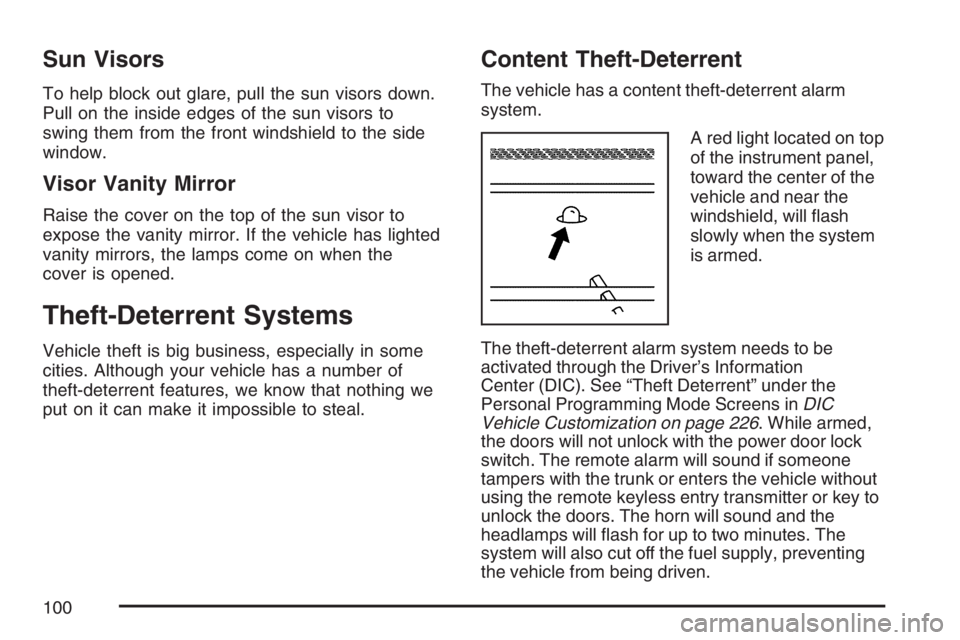
Sun Visors
To help block out glare, pull the sun visors down.
Pull on the inside edges of the sun visors to
swing them from the front windshield to the side
window.
Visor Vanity Mirror
Raise the cover on the top of the sun visor to
expose the vanity mirror. If the vehicle has lighted
vanity mirrors, the lamps come on when the
cover is opened.
Theft-Deterrent Systems
Vehicle theft is big business, especially in some
cities. Although your vehicle has a number of
theft-deterrent features, we know that nothing we
put on it can make it impossible to steal.
Content Theft-Deterrent
The vehicle has a content theft-deterrent alarm
system.
A red light located on top
of the instrument panel,
toward the center of the
vehicle and near the
windshield, will �ash
slowly when the system
is armed.
The theft-deterrent alarm system needs to be
activated through the Driver’s Information
Center (DIC). See “Theft Deterrent” under the
Personal Programming Mode Screens inDIC
Vehicle Customization on page 226. While armed,
the doors will not unlock with the power door lock
switch. The remote alarm will sound if someone
tampers with the trunk or enters the vehicle without
using the remote keyless entry transmitter or key to
unlock the doors. The horn will sound and the
headlamps will �ash for up to two minutes. The
system will also cut off the fuel supply, preventing
the vehicle from being driven.
100
Page 121 of 526
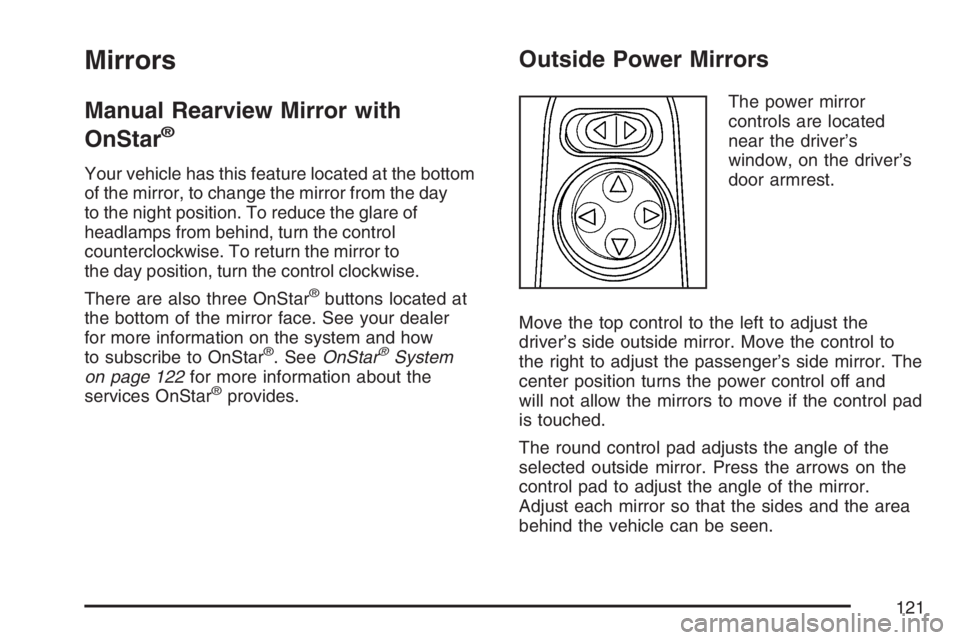
Mirrors
Manual Rearview Mirror with
OnStar
®
Your vehicle has this feature located at the bottom
of the mirror, to change the mirror from the day
to the night position. To reduce the glare of
headlamps from behind, turn the control
counterclockwise. To return the mirror to
the day position, turn the control clockwise.
There are also three OnStar
®buttons located at
the bottom of the mirror face. See your dealer
for more information on the system and how
to subscribe to OnStar
®. SeeOnStar®System
on page 122for more information about the
services OnStar
®provides.
Outside Power Mirrors
The power mirror
controls are located
near the driver’s
window, on the driver’s
door armrest.
Move the top control to the left to adjust the
driver’s side outside mirror. Move the control to
the right to adjust the passenger’s side mirror. The
center position turns the power control off and
will not allow the mirrors to move if the control pad
is touched.
The round control pad adjusts the angle of the
selected outside mirror. Press the arrows on the
control pad to adjust the angle of the mirror.
Adjust each mirror so that the sides and the area
behind the vehicle can be seen.
121
Page 122 of 526
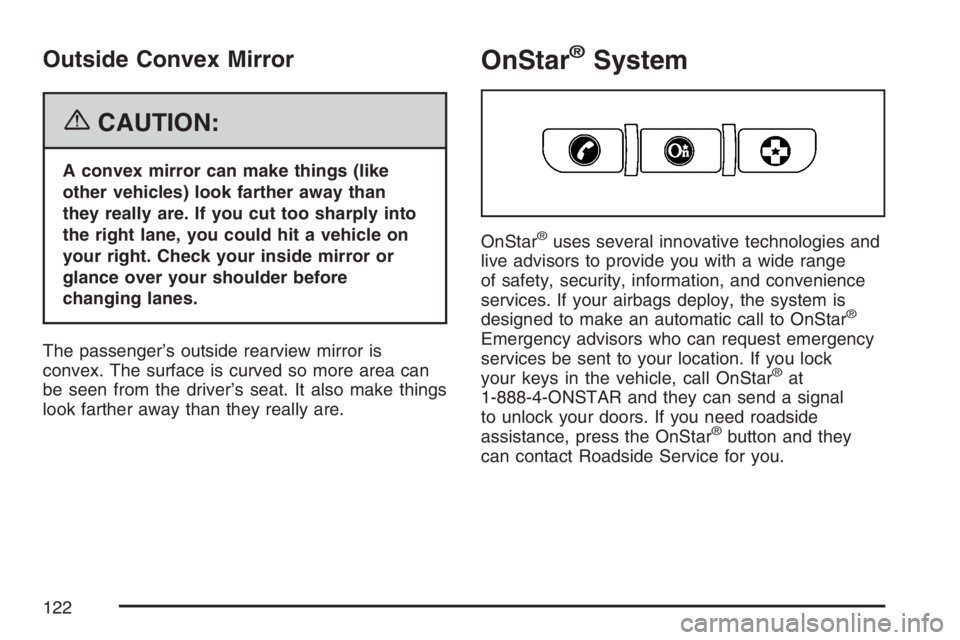
Outside Convex Mirror
{CAUTION:
A convex mirror can make things (like
other vehicles) look farther away than
they really are. If you cut too sharply into
the right lane, you could hit a vehicle on
your right. Check your inside mirror or
glance over your shoulder before
changing lanes.
The passenger’s outside rearview mirror is
convex. The surface is curved so more area can
be seen from the driver’s seat. It also make things
look farther away than they really are.
OnStar®System
OnStar®uses several innovative technologies and
live advisors to provide you with a wide range
of safety, security, information, and convenience
services. If your airbags deploy, the system is
designed to make an automatic call to OnStar
®
Emergency advisors who can request emergency
services be sent to your location. If you lock
your keys in the vehicle, call OnStar
®at
1-888-4-ONSTAR and they can send a signal
to unlock your doors. If you need roadside
assistance, press the OnStar
®button and they
can contact Roadside Service for you.
122
Page 300 of 526
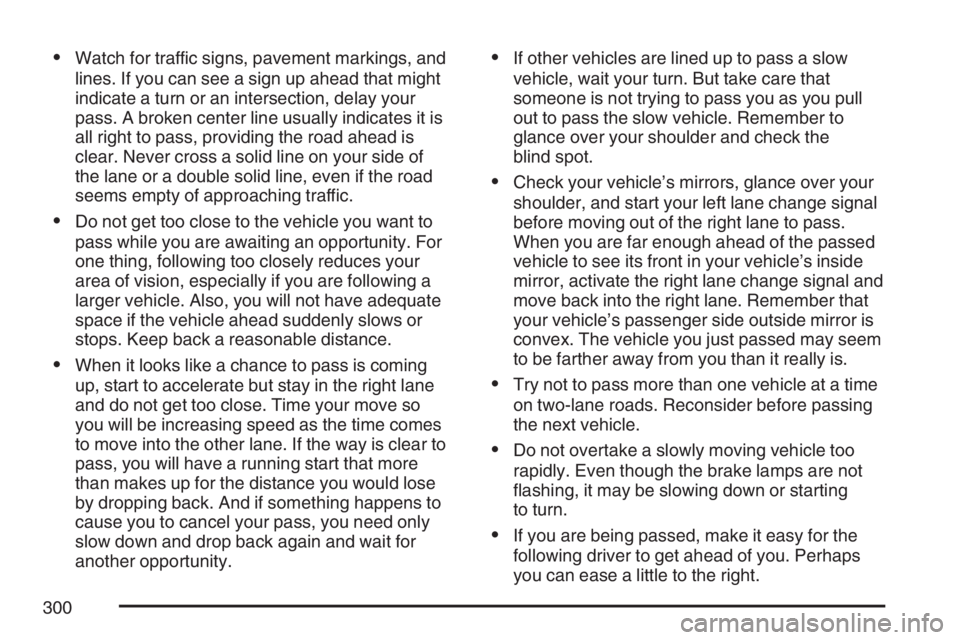
Watch for traffic signs, pavement markings, and
lines. If you can see a sign up ahead that might
indicate a turn or an intersection, delay your
pass. A broken center line usually indicates it is
all right to pass, providing the road ahead is
clear. Never cross a solid line on your side of
the lane or a double solid line, even if the road
seems empty of approaching traffic.
Do not get too close to the vehicle you want to
pass while you are awaiting an opportunity. For
one thing, following too closely reduces your
area of vision, especially if you are following a
larger vehicle. Also, you will not have adequate
space if the vehicle ahead suddenly slows or
stops. Keep back a reasonable distance.
When it looks like a chance to pass is coming
up, start to accelerate but stay in the right lane
and do not get too close. Time your move so
you will be increasing speed as the time comes
to move into the other lane. If the way is clear to
pass, you will have a running start that more
than makes up for the distance you would lose
by dropping back. And if something happens to
cause you to cancel your pass, you need only
slow down and drop back again and wait for
another opportunity.
If other vehicles are lined up to pass a slow
vehicle, wait your turn. But take care that
someone is not trying to pass you as you pull
out to pass the slow vehicle. Remember to
glance over your shoulder and check the
blind spot.
Check your vehicle’s mirrors, glance over your
shoulder, and start your left lane change signal
before moving out of the right lane to pass.
When you are far enough ahead of the passed
vehicle to see its front in your vehicle’s inside
mirror, activate the right lane change signal and
move back into the right lane. Remember that
your vehicle’s passenger side outside mirror is
convex. The vehicle you just passed may seem
to be farther away from you than it really is.
Try not to pass more than one vehicle at a time
on two-lane roads. Reconsider before passing
the next vehicle.
Do not overtake a slowly moving vehicle too
rapidly. Even though the brake lamps are not
�ashing, it may be slowing down or starting
to turn.
If you are being passed, make it easy for the
following driver to get ahead of you. Perhaps
you can ease a little to the right.
300
Page 302 of 526

Learn to recognize warning clues — such as
enough water, ice, or packed snow on the road to
make a mirrored surface — and slow down when
you have any doubt.
If you have the Anti-Lock Brake System (ABS),
remember: It helps avoid only the braking skid. If
you do not have ABS, then in a braking skid,
where the wheels are no longer rolling, release
enough pressure on the brakes to get the wheels
rolling again. This restores steering control.
Push the brake pedal down steadily when you
have to stop suddenly. As long as the wheels are
rolling, you will have steering control.
Driving at Night
Night driving is more dangerous than day driving.
One reason is that some drivers are likely to
be impaired — by alcohol or drugs, with night
vision problems, or by fatigue.
Here are some tips on night driving.
Drive defensively.
Do not drink and drive.
Adjust the inside rearview mirror to reduce the
glare from headlamps behind you.
Since you cannot see as well, you may need
to slow down and keep more space between
you and other vehicles.
Slow down, especially on higher speed roads.
Your vehicle’s headlamps can light up only so
much road ahead.
In remote areas, watch for animals.
If you are tired, pull off the road in a safe
place and rest.
No one can see as well at night as in the daytime.
But as we get older these differences increase.
A 50-year-old driver may require at least twice as
much light to see the same thing at night as a
20-year-old.
What you do in the daytime can also affect your
night vision. For example, if you spend the
day in bright sunshine you are wise to wear
sunglasses. Your eyes will have less trouble
adjusting to night. But if you are driving, do not
wear sunglasses at night. They may cut down on
glare from headlamps, but they also make a
lot of things invisible.
302
Page 307 of 526
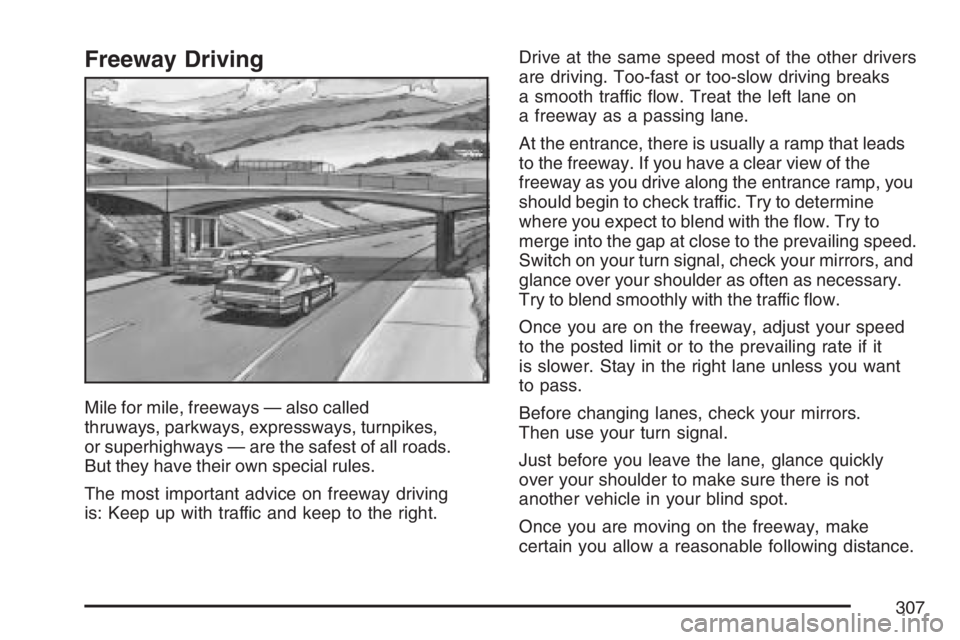
Freeway Driving
Mile for mile, freeways — also called
thruways, parkways, expressways, turnpikes,
or superhighways — are the safest of all roads.
But they have their own special rules.
The most important advice on freeway driving
is: Keep up with traffic and keep to the right.Drive at the same speed most of the other drivers
are driving. Too-fast or too-slow driving breaks
a smooth traffic �ow. Treat the left lane on
a freeway as a passing lane.
At the entrance, there is usually a ramp that leads
to the freeway. If you have a clear view of the
freeway as you drive along the entrance ramp, you
should begin to check traffic. Try to determine
where you expect to blend with the �ow. Try to
merge into the gap at close to the prevailing speed.
Switch on your turn signal, check your mirrors, and
glance over your shoulder as often as necessary.
Try to blend smoothly with the traffic �ow.
Once you are on the freeway, adjust your speed
to the posted limit or to the prevailing rate if it
is slower. Stay in the right lane unless you want
to pass.
Before changing lanes, check your mirrors.
Then use your turn signal.
Just before you leave the lane, glance quickly
over your shoulder to make sure there is not
another vehicle in your blind spot.
Once you are moving on the freeway, make
certain you allow a reasonable following distance.
307
Page 309 of 526

Highway Hypnosis
Is there actually such a condition as highway
hypnosis? Or is it just plain falling asleep at the
wheel? Call it highway hypnosis, lack of
awareness, or whatever.
There is something about an easy stretch of road
with the same scenery, along with the hum of the
tires on the road, the drone of the engine, and the
rush of the wind against the vehicle that can make
you sleepy. Do not let it happen to you! If it does,
your vehicle can leave the road in less than a
second, and you could crash and be injured.
What can you do about highway hypnosis?
First, be aware that it can happen.
Then here are some tips:
Make sure your vehicle is well ventilated,
with a comfortably cool interior.
Keep your eyes moving. Scan the road ahead
and to the sides. Check your rearview mirrors
and your instruments frequently.
If you get sleepy, pull off the road into a rest,
service, or parking area and take a nap, get
some exercise, or both. For safety, treat
drowsiness on the highway as an emergency.
Hill and Mountain Roads
Driving on steep hills or mountains is different
from driving in �at or rolling terrain.
309
Page 328 of 526
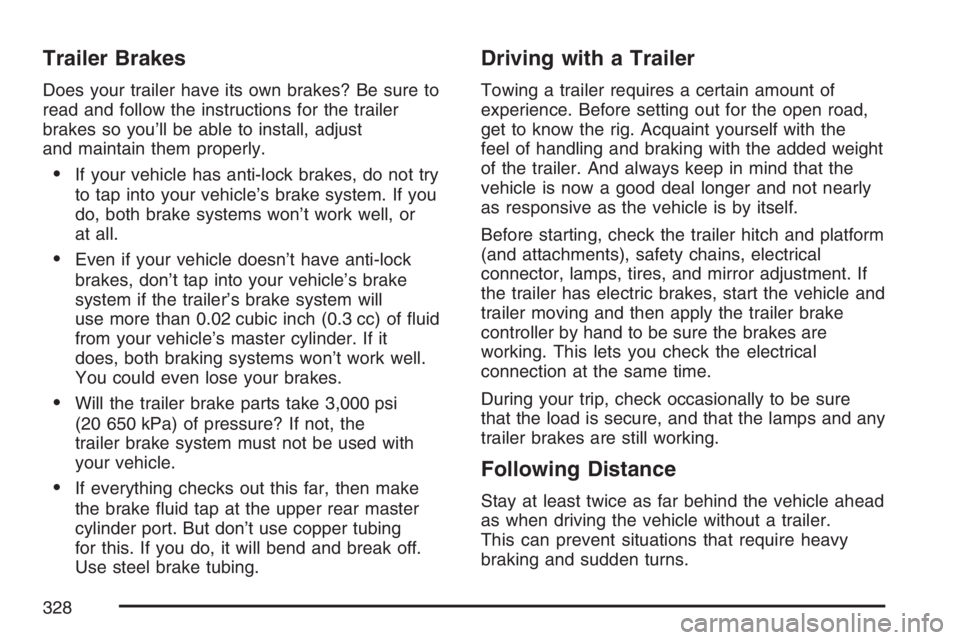
Trailer Brakes
Does your trailer have its own brakes? Be sure to
read and follow the instructions for the trailer
brakes so you’ll be able to install, adjust
and maintain them properly.
If your vehicle has anti-lock brakes, do not try
to tap into your vehicle’s brake system. If you
do, both brake systems won’t work well, or
at all.
Even if your vehicle doesn’t have anti-lock
brakes, don’t tap into your vehicle’s brake
system if the trailer’s brake system will
use more than 0.02 cubic inch (0.3 cc) of �uid
from your vehicle’s master cylinder. If it
does, both braking systems won’t work well.
You could even lose your brakes.
Will the trailer brake parts take 3,000 psi
(20 650 kPa) of pressure? If not, the
trailer brake system must not be used with
your vehicle.
If everything checks out this far, then make
the brake �uid tap at the upper rear master
cylinder port. But don’t use copper tubing
for this. If you do, it will bend and break off.
Use steel brake tubing.
Driving with a Trailer
Towing a trailer requires a certain amount of
experience. Before setting out for the open road,
get to know the rig. Acquaint yourself with the
feel of handling and braking with the added weight
of the trailer. And always keep in mind that the
vehicle is now a good deal longer and not nearly
as responsive as the vehicle is by itself.
Before starting, check the trailer hitch and platform
(and attachments), safety chains, electrical
connector, lamps, tires, and mirror adjustment. If
the trailer has electric brakes, start the vehicle and
trailer moving and then apply the trailer brake
controller by hand to be sure the brakes are
working. This lets you check the electrical
connection at the same time.
During your trip, check occasionally to be sure
that the load is secure, and that the lamps and any
trailer brakes are still working.
Following Distance
Stay at least twice as far behind the vehicle ahead
as when driving the vehicle without a trailer.
This can prevent situations that require heavy
braking and sudden turns.
328